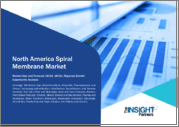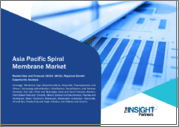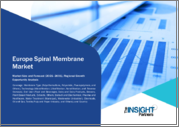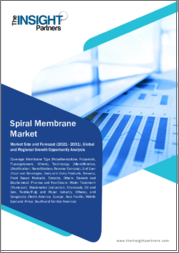
|
시장보고서
상품코드
1662649
나선형 멤브레인 시장 예측(-2030년) : 유형별, 재료별, 기술별, 용도별, 최종사용자별, 지역별 세계 분석Spiral Membrane Market Forecasts to 2030 - Global Analysis By Type, Material, Technology, Application, End User and By Geography |
||||||
Stratistics MRC에 따르면, 나선형 멤브레인 세계 시장은 2024년 92억 3,000만 달러로 CAGR 12.5%로 2030년에는 187억 3,000만 달러에 달할 것으로 예측됩니다.
나선형 멤브레인은 수처리 공정에서 일반적으로 사용되는 여과 기술의 일종입니다. 나선형으로 감긴 반투과성 막으로 구성되어 있어 액체에서 오염물질을 효율적으로 분리할 수 있습니다. 이 설계는 표면적을 증가시켜 역삼투, 한외여과, 나노여과와 같은 용도의 여과 공정을 강화합니다. 나선형 멤브레인은 높은 효율과 컴팩트한 디자인으로 정수, 식음료, 제약, 폐수처리 등의 산업에서 널리 사용되고 있습니다.
미국 노동 통계국에 따르면 2020년 식품에 대한 지출은 10.4% 감소했으며, 그 원동력은 32.5% 감소라는 가정 외 식품에 대한 지출 감소입니다.
수처리에 대한 수요 증가
전 세계적으로 물 부족에 대한 우려가 커지면서 효율적인 물 여과 솔루션에 대한 수요가 증가하고 있습니다. 나선형 멤브레인은 해수 담수화, 폐수처리, 정화 절차, 특히 역삼투압(RO) 시스템에 널리 채택되고 있습니다. 멤브레인 재료의 개선과 함께 불순물 제거 효과는 안전하고 깨끗한 물을 공급할 수 있는 완벽한 방법이 되었습니다. 수처리 산업에서 나선형 멤브레인 기술의 채택은 특히 물 공급이 제한된 지역에서 산업 및 지방 자치 단체의 요구에 의해 이러한 수요 증가에 힘입어 증가하고 있습니다.
막의 제한된 수명
나선형 멤브레인은 시간이 지남에 따라 오염, 스케일링 및 마모로 인해 여과 작업의 효율성이 저하됩니다. 최적의 성능을 유지하려면 잦은 교체와 세척이 필요하며, 이는 운영 비용을 증가시킵니다. 수처리량이 많은 산업이나 비용 효율성을 위해 멤브레인 수명을 연장하는 것이 필수적인 산업에서는 이러한 제약을 극복하는 것이 특히 어려울 수 있습니다. 나선형 멤브레인 장기 사용의 주요 장애물은 멤브레인 재료가 개선되더라도 빈번한 유지보수 및 최종 교체가 필요하다는 점입니다.
해수담수화 프로젝트 수요 증가
담수화는 특히 건조한 지역에서 담수 자원이 더욱 제한됨에 따라 깨끗한 식수를 공급하기 위한 중요한 전략으로 떠오르고 있습니다. 나선형 멤브레인(특히 역삼투압(RO) 시스템에서 볼 수 있는 멤브레인)은 바닷물에서 염분과 불순물을 제거하는 탁월한 효과로 인해 해수 담수화 기술의 최전선에 있습니다. 인구 증가, 도시화, 기후 변화의 영향도 이러한 수요를 촉진하는 요인으로 작용하고 있으며, 전 세계적으로 대규모 해수 담수화 시설에 대한 투자를 촉진하고 정수용 나선형 멤브레인 기술의 이용이 크게 증가하고 있습니다.
저소득 지역에서의 채용은 제한적
초기 투자, 설치 및 유지보수 비용이 높기 때문에 개발도상국, 특히 예산이 한정된 지역에서는 이러한 첨단 여과 시스템을 도입하기가 어렵습니다. 또한, 나선형 멤브레인 시스템의 운영 및 유지보수에는 전문적인 기술 전문 지식이 필요하기 때문에 채택이 더욱 제한적일 수 있습니다. 그 결과, 인프라와 재원이 제한된 지역에서는 물 부족과 오염에 대응하는 데 있어 나선형 멤브레인의 잠재적 이점에도 불구하고, 더 저렴하고 덜 효율적인 수처리 기술에 의존하게 되어 나선형 멤브레인의 보급을 저해할 수 있습니다.
COVID-19의 영향
위생에 대한 인식이 높아지고 깨끗한 물에 대한 필요성이 높아지면서 수처리 솔루션에 대한 수요가 증가하여 특히 지방 자치 단체 및 의료 부문에서 나선형 멤브레인 시장에 이익을 가져다주었습니다. COVID-19는 제조 지연, 공급망 중단, 멤브레인 시스템 설치의 어려움 등을 유발하여 시장 성장에 영향을 미쳤습니다. 대규모 수처리 프로젝트의 중단 및 지연, 공공 및 민간 부문의 예산 억제요인 및 경제 불안으로 인한 대규모 수처리 프로젝트의 중단 및 지연도 전체 시장 성장을 둔화시켰습니다.
예측 기간 동안 폴리아미드 부문이 가장 클 것으로 예상됩니다.
폴리아미드 부문은 우수한 내화학성, 높은 기계적 강도, 물 여과 효율성으로 인해 예측 기간 동안 가장 큰 시장 점유율을 차지할 것으로 예상됩니다. 폴리아미드는 일반적으로 해수 담수화 및 정수용 역삼투막에 사용되며, 염분 및 오염물질 제거에 탁월한 성능을 발휘합니다. 지속가능한 수처리 솔루션에 대한 수요가 증가함에 따라 폴리아미드의 내구성과 비용 효율성이 결합되어 폴리아미드가 선호되는 소재가 되었습니다. 또한, 폴리아미드 멤브레인 기술의 지속적인 발전으로 인해 제약, 식품 가공, 지자체 수처리 등의 산업에서 폴리아미드 멤브레인 채택이 더욱 확대되고 있습니다.
예측 기간 동안 해수 담수화 부문은 가장 높은 CAGR을 기록할 것으로 예상됩니다.
예측 기간 동안 해수 담수화 부문이 가장 높은 성장률을 보일 것으로 예상됩니다. 특히 건조 지역에서는 담수 자원의 부족이 심각해지고 있으며, 해수 담수화는 깨끗한 식수 공급을 위한 중요한 솔루션으로 부상하고 있습니다. 특히 역삼투압 시스템의 나선형 멤브레인은 염분 및 오염물질 제거 효율이 높아 해수 담수화에 매우 효과적입니다. 세계 인구 증가, 도시화, 기후 변화에 대한 우려는 해수 담수화 프로젝트에 대한 투자를 더욱 촉진하고, 나선형 멤브레인과 같은 첨단 멤브레인 기술에 대한 수요를 증가시키고 있습니다.
가장 큰 점유율을 차지하는 지역
예측 기간 동안 아시아태평양이 가장 큰 시장 점유율을 차지할 것으로 예상됩니다. 중국, 인도, 중동과 같은 국가들은 깨끗한 물에 대한 수요 증가에 대응하기 위해 해수 담수화 및 폐수처리를 포함한 수처리 기술에 많은 투자를 하고 있습니다. 또한, 이 지역의 대규모 제조 기반과 확대되는 식음료 산업은 여과 및 분리 공정에 나선형 멤브레인 기술의 채택을 더욱 촉진하여 이 지역의 시장 성장을 가속화하고 있습니다.
CAGR이 가장 높은 지역
예측 기간 동안 북미가 가장 높은 CAGR을 보일 것으로 예상되며, 이는 특히 해수 담수화, 도시 물 정화 및 산업 응용 분야에서 고급 수처리 기술에 대한 수요 증가에 기인합니다. 엄격한 환경 규제와 지속가능성에 대한 관심으로 인해 산업계는 효율적인 여과 시스템을 채택하는 경향이 있습니다. 이 지역에서는 특히 노후화된 수처리 플랜트의 인프라 개보수에 대한 투자도 시장을 견인하고 있습니다. 또한, 농업, 식음료, 제약 부문에서 깨끗한 물에 대한 수요가 증가함에 따라 북미 전역에서 나선형 멤브레인 기술의 채택이 더욱 증가하고 있습니다.
무료 커스터마이징 서비스
본 보고서를 구독하는 고객은 다음과 같은 무료 맞춤화 옵션 중 하나를 이용할 수 있습니다.
- 기업 소개
- 추가 시장 진입 기업의 종합적인 프로파일링(최대 3개사)
- 주요 기업 SWOT 분석(3개사까지)
- 지역 세분화
- 고객의 관심에 따른 주요 국가별 시장 추정 및 예측, CAGR(주: 타당성 검토에 따른)
- 경쟁사 벤치마킹
- 제품 포트폴리오, 지리적 입지, 전략적 제휴를 통한 주요 기업 벤치마킹
목차
제1장 주요 요약
제2장 서문
- 개요
- 이해관계자
- 조사 범위
- 조사 방법
- 데이터 마이닝
- 데이터 분석
- 데이터 검증
- 조사 접근법
- 조사 정보 출처
- 1차 조사 정보 출처
- 2차 조사 정보 출처
- 가정
제3장 시장 동향 분석
- 소개
- 성장 촉진요인
- 성장 억제요인
- 기회
- 위협
- 기술 분석
- 용도 분석
- 최종사용자 분석
- 신흥 시장
- COVID-19의 영향
제4장 Porter's Five Forces 분석
- 공급 기업의 교섭력
- 구매자의 교섭력
- 대체품의 위협
- 신규 참여업체의 위협
- 경쟁 기업 간의 경쟁 관계
제5장 세계의 나선형 멤브레인 시장 : 유형별
- 소개
- 나노여과(NF) 막
- 역삼투막(RO)
- 한외여과(UF) 막
- 정밀여과(MF) 막
- 기타
제6장 세계의 나선형 멤브레인 시장 : 재료별
- 소개
- 폴리에테르 설폰(PES)
- 폴리아미드
- 셀룰로오스 아세테이트
- 폴리설폰
- 기타 자료
제7장 세계의 나선형 멤브레인 시장 : 기술별
- 소개
- 막여과
- 전기투석
- 정전용량 탈이온
제8장 세계의 나선형 멤브레인 시장 : 용도별
- 소개
- 식품 및 음료
- 상하수 처리
- 화학·석유화학제품
- 의약품
- 해수담수화
- 유분리
- 기타
제9장 세계의 나선형 멤브레인 시장 : 최종사용자별
- 소개
- 산업용 여과
- 도시 수처리
- 주거용
- 기타
제10장 세계의 나선형 멤브레인 시장 : 지역별
- 소개
- 북미
- 미국
- 캐나다
- 멕시코
- 유럽
- 독일
- 영국
- 이탈리아
- 프랑스
- 스페인
- 기타 유럽
- 아시아태평양
- 일본
- 중국
- 인도
- 호주
- 뉴질랜드
- 한국
- 기타 아시아태평양
- 남미
- 아르헨티나
- 브라질
- 칠레
- 기타 남미
- 중동 및 아프리카
- 사우디아라비아
- 아랍에미리트
- 카타르
- 남아프리카공화국
- 기타 중동 및 아프리카
제11장 주요 개발
- 계약, 파트너십, 협업, 합작투자
- 인수와 합병
- 신제품 발매
- 사업 확대
- 기타 주요 전략
제12장 기업 개요
- Dow Inc.
- Toray Industries, Inc.
- LG Chem Ltd.
- Pentair plc
- SUEZ Water Technologies & Solutions
- Pall Corporation
- Mitsubishi Chemical Corporation
- 3M Company
- Veolia North America
- Parker Hannifin Corporation
- General Electric(GE) Water & Process Technologies
- Koch Membrane Systems, Inc.
- Toyobo Co., Ltd.
- Filtration Group Corporation
- Lanxess AG
- Sartorius AG
According to Stratistics MRC, the Global Spiral Membrane Market is accounted for $9.23 billion in 2024 and is expected to reach $18.73 billion by 2030 growing at a CAGR of 12.5% during the forecast period. A spiral membrane is a type of filtration technology commonly used in water treatment processes. It consists of a semi-permeable membrane wound in a spiral configuration, which allows for the efficient separation of contaminants from liquids. This design increases surface area, enhancing the filtration process for applications such as reverse osmosis, ultrafiltration, and nanofiltration. Spiral membranes are widely used in industries like water purification, food and beverage, pharmaceuticals, and wastewater treatment due to their high efficiency and compact design.
According to the U.S. Bureau of Labour Statistics, the spending on food showed a decrease of 10.4% in 2020, driven by a fall in the spending for food away from home with a 32.5% decline.
Market Dynamics:
Driver:
Rising demand for water treatment
The need for efficient water filtration solutions has increased as concerns about worldwide water scarcity grow. Spiral membranes are extensively employed in desalination, wastewater treatment, and purification procedures, especially in reverse osmosis (RO) systems. Together with improvements in membrane materials, their effectiveness in eliminating impurities makes them the perfect way to supply safe, clean water. Spiral membrane technology adoption in the water treatment industry is fuelled by this rising demand, which is fuelled by both industrial and municipal needs, especially in areas with limited water supplies.
Restraint:
Limited lifespan of membranes
The efficiency of spiral membranes in filtration operations is decreased as a result of fouling, scaling, and wear over time. Maintaining optimal performance necessitates frequent replacement or cleaning, which raises operating expenses. High water throughput industries or those where a longer membrane lifespan is essential for cost-effectiveness may find this restriction especially difficult to overcome. A major obstacle to spiral membranes' long-term use in several applications is their requirement for frequent maintenance and eventual replacement, even with improvements in membrane materials.
Opportunity:
Growing demand in desalination projects
Seawater desalination has emerged as a key strategy for supplying clean drinking water as freshwater resources grow more limited, particularly in dry areas. Because of their exceptional effectiveness in eliminating salt and impurities from seawater, spiral membranes-especially those found in reverse osmosis (RO) systems-are at the forefront of desalination technology. Population increase, urbanization, and the effects of climate change are further factors driving this need, which in turn is propelling investments in massive desalination facilities across the globe and greatly increasing the use of spiral membrane technology for water purification.
Threat:
Limited adoption in low-income regions
High initial capital investment, installation, and maintenance costs make it difficult for developing countries to implement these advanced filtration systems, especially in areas with constrained budgets. Additionally, the need for specialized technical expertise for operation and maintenance of spiral membrane systems can further limit adoption. As a result, regions with limited infrastructure and financial resources may rely on more affordable, less efficient water treatment technologies, hindering the widespread adoption of spiral membranes despite their potential benefits in addressing water scarcity and pollution.
Covid-19 Impact
Increased awareness of sanitation and the need for clean water led to a rise in the demand for water treatment solutions, which benefited the spiral membrane market, especially in the municipal and healthcare sectors. The pandemic impacted market growth by causing manufacturing delays, supply chain interruptions, and difficulties installing membrane systems. Large-scale water treatment project cancellations or delays were also caused by budgetary restraints and economic uncertainty in both the public and private sectors, which slowed the pandemic's total market expansion.
The polyamide segment is expected to be the largest during the forecast period
The polyamide segment is expected to account for the largest market share during the forecast period, due to its excellent chemical resistance, high mechanical strength, and efficiency in water filtration. It is commonly used in reverse osmosis membranes for desalination and water purification, offering superior performance in removing salts and contaminants. The growing demand for sustainable water treatment solutions, coupled with polyamide's durability and cost-effectiveness, makes it a preferred material. Additionally, continuous advancements in polyamide membrane technology further enhance its adoption across industries like pharmaceuticals, food processing, and municipal water treatment.
The desalination segment is expected to have the highest CAGR during the forecast period
Over the forecast period, the desalination segment is predicted to witness the highest growth rate. As freshwater resources become increasingly scarce, particularly in arid regions, seawater desalination has emerged as a vital solution for providing clean drinking water. Spiral membranes, especially in reverse osmosis systems, are highly effective in desalinating seawater due to their efficiency in removing salts and contaminants. The rising global population, urbanization, and climate change concerns further boost investments in desalination projects, driving the demand for advanced membrane technologies like spiral membranes.
Region with largest share:
During the forecast period, Asia Pacific region is expected to hold the largest market share. Countries like China, India, and the Middle East are investing heavily in water treatment technologies, including desalination and wastewater treatment, to address the growing demand for clean water. Additionally, the region's large manufacturing base and expanding food and beverage industries further fuel the adoption of spiral membrane technologies for filtration and separation processes, accelerating market growth in the region.
Region with highest CAGR:
Over the forecast period, the North America region is anticipated to exhibit the highest CAGR, owing to increasing demand for advanced water treatment technologies, particularly in desalination, municipal water purification, and industrial applications. Stringent environmental regulations and a strong emphasis on sustainability push industries to adopt efficient filtration systems. The region's investment in infrastructure upgrades, particularly in aging water treatment plants, also boosts the market. Additionally, the growing demand for clean water in agriculture, food and beverage, and pharmaceutical sectors further propels the adoption of spiral membrane technology across North America.
Key players in the market
Some of the key players profiled in the Spiral Membrane Market include Dow Inc., Toray Industries, Inc., LG Chem Ltd., Pentair plc, SUEZ Water Technologies & Solutions, Pall Corporation, Mitsubishi Chemical Corporation, 3M Company, Veolia North America, Parker Hannifin Corporation, General Electric (GE) Water & Process Technologies, Koch Membrane Systems, Inc., Toyobo Co., Ltd., Filtration Group Corporation, Lanxess AG, and Sartorius AG.
Key Developments:
In December 2024, Dowopens announced that it has entered into a definitive agreement to sell a 40% equity stake in select U.S. Gulf Coast infrastructure assets to a fund managed by Macquarie Asset Management, a leading global infrastructure and energy asset manager.
In November 2024, LG Chem and the extrusion machine manufacturer Reifenhauser have signed a Memorandum of Understanding (MOU), confirming further extensive cooperation. The aim is to further develop and market competitive Machine Direction Oriented (MDO)-PE blown films and flat films for recyclable packaging. The partners are building on a successful track record: In May 2024, the companies had presented the world's first MDO-PE film only 18 micrometers (µm).
Types Covered:
- Nanofiltration (NF) Membranes
- Reverse Osmosis (RO) Membranes
- Ultrafiltration (UF) Membranes
- Microfiltration (MF) Membranes
- Other Types
Materials Covered:
- Polyethersulfone (PES)
- Polyamide
- Cellulose Acetate
- Polysulfone
- Other Materials
Technologies Covered:
- Membrane Filtration
- Electrodialysis
- Capacitive Deionization
Applications Covered:
- Food & Beverages
- Water & Wastewater Treatment
- Chemicals & Petrochemicals
- Pharmaceuticals
- Desalination
- Oil Separation
- Other Applications
End Users Covered:
- Industrial Filtration
- Municipal Water Treatment
- Residential
- Other End Users
Regions Covered:
- North America
- US
- Canada
- Mexico
- Europe
- Germany
- UK
- Italy
- France
- Spain
- Rest of Europe
- Asia Pacific
- Japan
- China
- India
- Australia
- New Zealand
- South Korea
- Rest of Asia Pacific
- South America
- Argentina
- Brazil
- Chile
- Rest of South America
- Middle East & Africa
- Saudi Arabia
- UAE
- Qatar
- South Africa
- Rest of Middle East & Africa
What our report offers:
- Market share assessments for the regional and country-level segments
- Strategic recommendations for the new entrants
- Covers Market data for the years 2022, 2023, 2024, 2026, and 2030
- Market Trends (Drivers, Constraints, Opportunities, Threats, Challenges, Investment Opportunities, and recommendations)
- Strategic recommendations in key business segments based on the market estimations
- Competitive landscaping mapping the key common trends
- Company profiling with detailed strategies, financials, and recent developments
- Supply chain trends mapping the latest technological advancements
Free Customization Offerings:
All the customers of this report will be entitled to receive one of the following free customization options:
- Company Profiling
- Comprehensive profiling of additional market players (up to 3)
- SWOT Analysis of key players (up to 3)
- Regional Segmentation
- Market estimations, Forecasts and CAGR of any prominent country as per the client's interest (Note: Depends on feasibility check)
- Competitive Benchmarking
- Benchmarking of key players based on product portfolio, geographical presence, and strategic alliances
Table of Contents
1 Executive Summary
2 Preface
- 2.1 Abstract
- 2.2 Stake Holders
- 2.3 Research Scope
- 2.4 Research Methodology
- 2.4.1 Data Mining
- 2.4.2 Data Analysis
- 2.4.3 Data Validation
- 2.4.4 Research Approach
- 2.5 Research Sources
- 2.5.1 Primary Research Sources
- 2.5.2 Secondary Research Sources
- 2.5.3 Assumptions
3 Market Trend Analysis
- 3.1 Introduction
- 3.2 Drivers
- 3.3 Restraints
- 3.4 Opportunities
- 3.5 Threats
- 3.6 Technology Analysis
- 3.7 Application Analysis
- 3.8 End User Analysis
- 3.9 Emerging Markets
- 3.10 Impact of Covid-19
4 Porters Five Force Analysis
- 4.1 Bargaining power of suppliers
- 4.2 Bargaining power of buyers
- 4.3 Threat of substitutes
- 4.4 Threat of new entrants
- 4.5 Competitive rivalry
5 Global Spiral Membrane Market, By Type
- 5.1 Introduction
- 5.2 Nanofiltration (NF) Membranes
- 5.3 Reverse Osmosis (RO) Membranes
- 5.4 Ultrafiltration (UF) Membranes
- 5.5 Microfiltration (MF) Membranes
- 5.6 Other Types
6 Global Spiral Membrane Market, By Material
- 6.1 Introduction
- 6.2 Polyethersulfone (PES)
- 6.3 Polyamide
- 6.4 Cellulose Acetate
- 6.5 Polysulfone
- 6.6 Other Materials
7 Global Spiral Membrane Market, By Technology
- 7.1 Introduction
- 7.2 Membrane Filtration
- 7.3 Electrodialysis
- 7.4 Capacitive Deionization
8 Global Spiral Membrane Market, By Application
- 8.1 Introduction
- 8.2 Food & Beverages
- 8.3 Water & Wastewater Treatment
- 8.4 Chemicals & Petrochemicals
- 8.5 Pharmaceuticals
- 8.6 Desalination
- 8.7 Oil Separation
- 8.8 Other Applications
9 Global Spiral Membrane Market, By End User
- 9.1 Introduction
- 9.2 Industrial Filtration
- 9.3 Municipal Water Treatment
- 9.4 Residential
- 9.5 Other End Users
10 Global Spiral Membrane Market, By Geography
- 10.1 Introduction
- 10.2 North America
- 10.2.1 US
- 10.2.2 Canada
- 10.2.3 Mexico
- 10.3 Europe
- 10.3.1 Germany
- 10.3.2 UK
- 10.3.3 Italy
- 10.3.4 France
- 10.3.5 Spain
- 10.3.6 Rest of Europe
- 10.4 Asia Pacific
- 10.4.1 Japan
- 10.4.2 China
- 10.4.3 India
- 10.4.4 Australia
- 10.4.5 New Zealand
- 10.4.6 South Korea
- 10.4.7 Rest of Asia Pacific
- 10.5 South America
- 10.5.1 Argentina
- 10.5.2 Brazil
- 10.5.3 Chile
- 10.5.4 Rest of South America
- 10.6 Middle East & Africa
- 10.6.1 Saudi Arabia
- 10.6.2 UAE
- 10.6.3 Qatar
- 10.6.4 South Africa
- 10.6.5 Rest of Middle East & Africa
11 Key Developments
- 11.1 Agreements, Partnerships, Collaborations and Joint Ventures
- 11.2 Acquisitions & Mergers
- 11.3 New Product Launch
- 11.4 Expansions
- 11.5 Other Key Strategies
12 Company Profiling
- 12.1 Dow Inc.
- 12.2 Toray Industries, Inc.
- 12.3 LG Chem Ltd.
- 12.4 Pentair plc
- 12.5 SUEZ Water Technologies & Solutions
- 12.6 Pall Corporation
- 12.7 Mitsubishi Chemical Corporation
- 12.8 3M Company
- 12.9 Veolia North America
- 12.10 Parker Hannifin Corporation
- 12.11 General Electric (GE) Water & Process Technologies
- 12.12 Koch Membrane Systems, Inc.
- 12.13 Toyobo Co., Ltd.
- 12.14 Filtration Group Corporation
- 12.15 Lanxess AG
- 12.16 Sartorius AG















